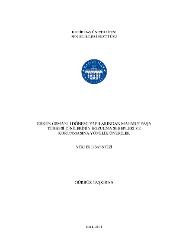| dc.contributor.advisor | Erkan Kösebay, Yonca | en_US |
| dc.contributor.author | Taskıran, Gurbuz | |
| dc.date.accessioned | 2019-07-12T08:41:29Z | en_US |
| dc.date.available | 2019-07-12T08:41:29Z | en_US |
| dc.date.issued | 2014 | en_US |
| dc.identifier.uri | https://hdl.handle.net/20.500.12469/2489 | |
| dc.description.abstract | Çini sanati Turk susleme sanati icinde onemli bir yere sahiptir. ozellikle Erken Osmanli Donemi cinilerinde cok renkli ve birbirinden farkli tekniklerin birarada uygulandigi gorulmektedir. ciniler bir yapi elemani olarak karekteristik ozelliklere sahiptir. Yapildiklari donemlere ozgu uygulama bicimleri ve uretim teknikleri vardir. cinilerin varligi tarihi yapilarda gozlemlenen bozulmalar ve bunlarin nedenlerinin tespit edilmesinde koruma ve onarim yontemlerinin saptanmasinda belirleyici bir unsur olarak karsimiza cikmaktadir. Bu calismada Erken Osmanli Donemi yapilarindan biri olan Mahmut Pasa Turbesi’nin dis cephe mozaik cinileri incelenmis olup yapida ve cinilerde gozlemlenen bozulmalar belgelenerek bunlarin nedenleri arastirilmis ve korumaya iliskin oneriler ve uygun yontemler belirtilmistir. Bu amacla cinilerin mimari yapilarda bir susleme ve yapi elemani olarak kullanimi bu malzemelerin sahip oldugu motif kompozisyon ve teknik ozellikler baglaminda degerlendirilmistir. Bir Erken Osmanli yapisi olan Mahmut Pasa Turbesi Selcuklu Donemi cini tekniklerini yansitan mozaik cinileriyle Selcuklu Donemi ile Osmanli Donemi arasindaki gecis evrelerine isik tutmaktadir. Dolayisiyla bu yapida bulunan mozaik cinilerin yapisal ozellikleri uygulama yontemleri hammadde icerikleri mimari yapida hangi malzemelerle birlikte kullanildiklarinin aydinlatilmasiyla onarim yontemlerinin belirlenmesinde ciniler onemli katki saglamaktadir. | en_US |
| dc.description.abstract | Art of tile has a significant place in Turkish ornamental arts. Implementation of various polychrome techniques and innovations is observed especially of the Early Ottoman period. Tiles have characteristic properties as a construction material. Application methods and production techniques of tiles reflect the periods they belong. Presence of tiles acts a decisive role in identification of deteriorations and in determination of conservation and restoration methods observed on historical constructions. In this study, mosaic tiles on the exterior facade of the Mahmut Paşa Tomb, which is one of the Early Ottoman structures is investigated. Moreover, appropriate conservation is defined after documentation of decay observed both on other construction materials and tiles, in consideration of their casuses of decay. For this purpose, use of tiles as an ornamentation and construction material in architectural structures is evaluated in the context of decoration, composition and technical aspects of the tiles. Being an Early Ottoman structure, the Mahmut Pasa Tomb, with its mosaic tiles reflecting the techniques applied in the Seljuk period, enlightens the transition stages from Seljuk to Ottoman. Thus, structural properties, implementation techniques and raw material contents of tiles used on this tomb substantially contribute to the identification of restoration methods by also revealing accompanying materials used with the tiles. | en_US |
| dc.language.iso | tur | en_US |
| dc.publisher | Kadir Has Üniversitesi | en_US |
| dc.rights | info:eu-repo/semantics/openAccess | en_US |
| dc.subject | Early Ottoman | en_US |
| dc.subject | Seljuk | en_US |
| dc.subject | Mosaic Art Tile | en_US |
| dc.subject | Preservation | en_US |
| dc.subject | Restoration | en_US |
| dc.subject | Erken Osmanlı | en_US |
| dc.subject | Selçuklu | en_US |
| dc.subject | Mozaik Çini | en_US |
| dc.subject | Koruma | en_US |
| dc.subject | Onarım | en_US |
| dc.title | Erken Osmanlı donemi yapılarından Mahmut Pasa türbesi çinilerinin bozulma sebepleri ve korunmasına yönelik öneriler | en_US |
| dc.type | masterThesis | en_US |
| dc.department | Enstitüler, Lisansüstü Eğitim Enstitüsü, Kültür Varlıklarını Koruma Ana Bilim Dalı | en_US |
| dc.relation.publicationcategory | Tez | en_US |
| dc.identifier.yoktezid | 352258 | en_US |
















